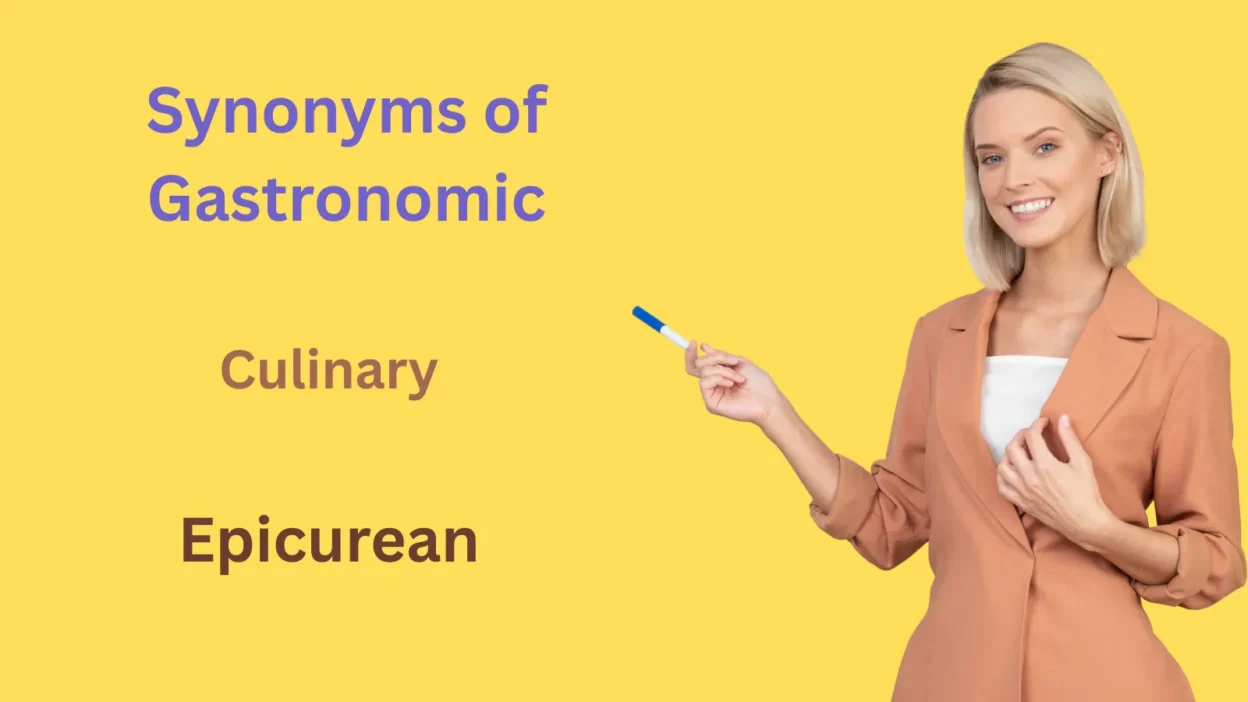Synonyms of gastronomic, such as culinary, epicurean, and gourmet, describe anything related to good food, cooking, or fine dining. For example, “culinary” highlights cooking skills or techniques, while “gourmet” emphasizes high-quality, carefully prepared dishes.
If you’re writing about restaurants, recipes, or food culture, choosing precise synonyms for gastronomic makes your descriptions flavorful and engaging. From casual meals to fine dining, the language of gastronomic celebrates the pleasures of taste.
These synonyms of gastronomic not only enhance your writing but also give readers a richer understanding of the art and enjoyment of food. Using the right synonym helps you show different aspects of food—from skill and artistry to taste and indulgence.
What Does Gastronomic Mean?
Gastronomic relates to cooking, food, or the enjoyment of fine meals. It often refers to:
- High-quality or sophisticated food
- Culinary skill and artistry
- Appreciation for taste and presentation
- Experiences related to fine dining
It’s not just about eating—it’s about savoring, creating, and celebrating food. Think of gastronomic as the art and joy of flavor in every dish.
Synonyms of Gastronomic with Meanings, Examples, and Usage Tips
1. Culinary
Description: Relating to cooking or the kitchen.
Example: “She enrolled in a top culinary school in Paris.”
Usage: The most common and versatile synonym; suitable for all contexts.
2. Epicurean
Description: Devoted to fine food and luxury, derived from the philosopher Epicurus.
Example: “The epicurean dinner featured truffle risotto and aged wines.”
Usage: Elegant, formal; ideal when emphasizing refined taste and pleasure.
3. Gourmet
Description: Involving high-quality, expertly prepared food.
Example: “He prepared a gourmet feast for the anniversary.”
Usage: Common in marketing, reviews, and upscale dining contexts.
4. Epicurious
Description: Showing an enthusiastic interest in food and cooking.
Example: “Her epicurious adventures led her to taste street food across Asia.”
Usage: Modern, lively; perfect for travel or food blogs.
5. Palatable
Description: Pleasant to taste or acceptable in flavor.
Example: “The chef made even simple vegetables palatable.”
Usage: Neutral; can be used for both literal and metaphorical appeal.
6. Savory
Description: Tasty, flavorful, or appetizing (often non-sweet foods).
Example: “The savory aroma filled the entire kitchen.”
Usage: Everyday or descriptive writing; focuses on sensory appeal.
7. Delectable
Description: Delicious and pleasing to the senses.
Example: “The buffet was filled with delectable pastries.”
Usage: Positive and expressive; great for reviews and descriptions.
8. Appetizing
Description: Stimulating the appetite; visually or aromatically pleasing.
Example: “The chef’s presentation made the dish even more appetizing.”
Usage: Casual to semi-formal; emphasizes sensory attraction.
9. Flavorful
Description: Rich in flavor or taste.
Example: “The curry was intensely flavorful.”
Usage: Everyday use; focuses on taste quality rather than sophistication.
10. Tasteful
Description: Showing good aesthetic or culinary judgment.
Example: “The restaurant’s decor and menu were equally tasteful.”
Usage: Broader than food; implies elegance and refinement.
11. Refined
Description: Elegant and polished in style, preparation, or taste.
Example: “Her refined palate made her an excellent wine critic.”
Usage: Ideal for formal writing about dining, manners, or art.
12. Artisanal
Description: Made by hand with traditional skill or craftsmanship.
Example: “They specialize in artisanal cheeses from local farms.”
Usage: Modern and trendy; perfect for small-scale or authentic food contexts.
13. Haute cuisine
Description: French for “high cooking,” meaning fine dining or elite gastronomy.
Example: “The restaurant is renowned for its haute cuisine menu.”
Usage: Formal, cultural; often used in luxury or Michelin-level discussions.
14. Epicure
Description: A person with refined taste in food and drink.
Example: “As an epicure, he sought out the city’s best chefs.”
Usage: Describes a person; elegant and slightly old-fashioned.
15. Foodie
Description: An enthusiast of good food and dining experiences.
Example: “Every foodie should visit this market at least once.”
Usage: Modern, casual; warm and friendly tone.
16. Decadent
Description: Rich, luxurious, and indulgent, often to excess.
Example: “The chocolate mousse was decadently smooth.”
Usage: Sensual and expressive; suitable for indulgent foods or luxury writing.
17. Relishing
Description: Taking great pleasure in taste or experience.
Example: “He was relishing every bite of his pasta.”
Usage: Descriptive, emotional; conveys enjoyment and satisfaction.
18. Edible
Description: Fit or safe to eat; sometimes used humorously or modestly.
Example: “The experiment turned out surprisingly edible.”
Usage: Informal; often used with irony or humor.
19. Sapid
Description: Having a strong, pleasant flavor.
Example: “The sapid broth left a lasting taste on the palate.”
Usage: Rare and literary; adds sophistication to descriptive writing.
20. Ambrosial
Description: Exceptionally pleasing to taste or smell; divine.
Example: “The ambrosial aroma of the bakery drew everyone inside.”
Usage: Poetic or formal; suitable for evocative or romantic tone.
21. Tasty
Description: Pleasing to the taste; flavorful and enjoyable.
Example: “Those are the tastiest tacos in town.”
Usage: Common, casual, positive; friendly and relatable.
22. Mouthwatering
Description: So appetizing that it causes you to salivate.
Example: “The mouthwatering roast was the highlight of the evening.”
Usage: Informal; visually or descriptively appealing.
23. Succulent
Description: Juicy, tender, and full of flavor.
Example: “The steak was succulent and perfectly cooked.”
Usage: Descriptive; ideal for meat or fruit-related writing.
24. Luscious
Description: Richly appealing to the senses, especially taste and smell.
Example: “The luscious berries glistened in the sunlight.”
Usage: Sensual and expressive; strong sensory or emotional tone.
25. Appetitive
Description: Relating to appetite or desire for food.
Example: “His appetitive instincts led him to the kitchen.”
Usage: Rare, formal; good for psychological or academic writing.
26. Food-related
Description: Concerning food or eating in general.
Example: “She’s researching food-related cultural traditions.”
Usage: Neutral and broad; ideal for academic or factual contexts.
27. Edacious
Description: Given to eating or devouring food eagerly.
Example: “His edacious curiosity extended to every new dish.”
Usage: Literary and rare; good for creative or poetic writing.
28. Saporous
Description: Having a distinct or pleasant taste.
Example: “The saporous sauce enhanced the pasta perfectly.”
Usage: Archaic or poetic; suitable for high literary tone.
29. Comestible
Description: Fit to eat; edible, often used humorously or formally.
Example: “All the comestibles on the table vanished within minutes.”
Usage: Formal or witty; sometimes used playfully in writing.
30. Delicatessen
Description: Fine prepared foods or luxurious edibles.
Example: “They sell imported delicatessen items from Italy.”
Usage: Refers to food itself or the shop; conveys sophistication.
How to Choose the Right Synonym
Your choice of a synonym for “gastronomic” depends on tone, audience, and intent:
- For professional or formal writing: Use culinary, haute cuisine, epicurean, or refined.
- For creative or literary writing: Choose expressive words like ambrosial, sapid, luscious, or succulent.
- For casual contexts: Tasty, mouthwatering, and foodie are natural and relatable.
- For academic tone: Appetitive, edacious, or food-related fit best.
- For branding or marketing: Gourmet, artisanal, and decadent are powerful and appealing to luxury audiences.
Cultural nuances also matter. For example, haute cuisine evokes European fine dining, while foodie connects more with modern global food culture. Epicurean implies philosophy and sophistication, whereas tasty or flavorful appeal to broader audiences with simplicity and warmth.
Conclusion :
The world of fine dining and culinary writing offers a rich palette of Synonyms of Gastronomic, each bringing its own nuance—from the sophistication of epicurean to the casual warmth of tasty. Using the right synonym enhances your descriptions, making dishes, meals, and experiences vivid, engaging, and memorable.
Whether crafting a food review, menu, or personal narrative, Synonyms of Gastronomic lets you capture not just taste but the emotion, artistry, and culture behind every bite.





